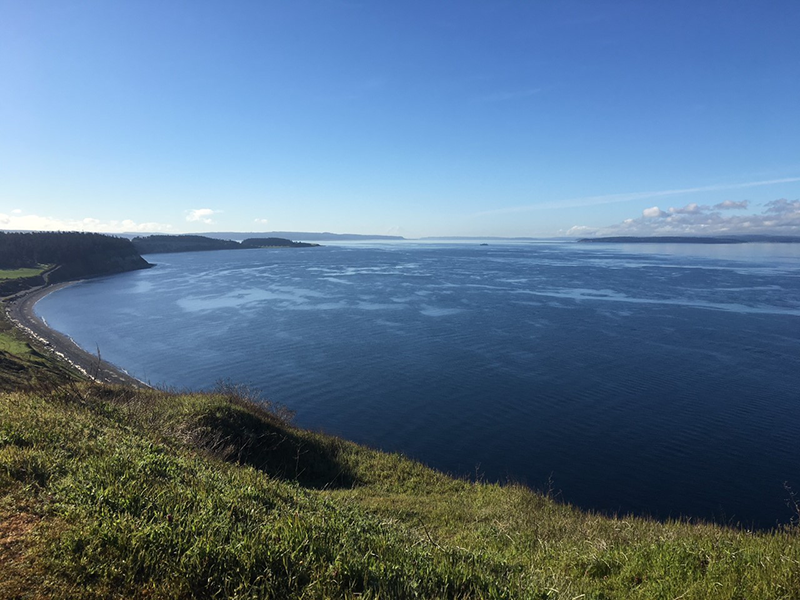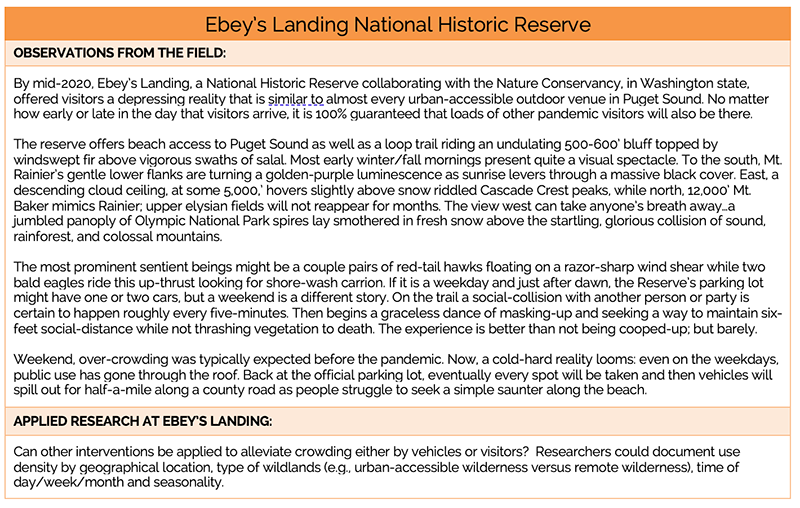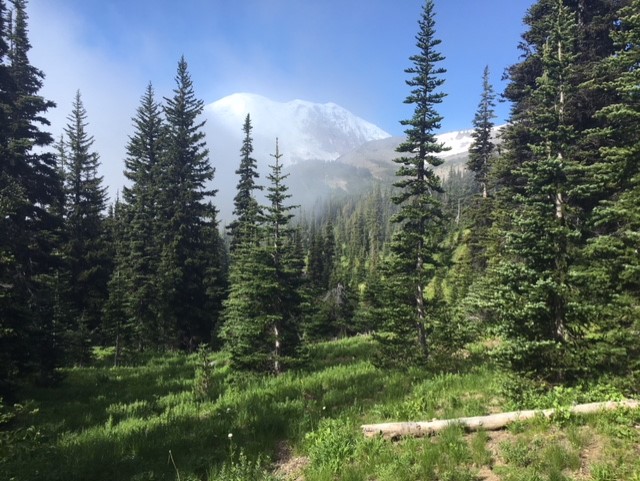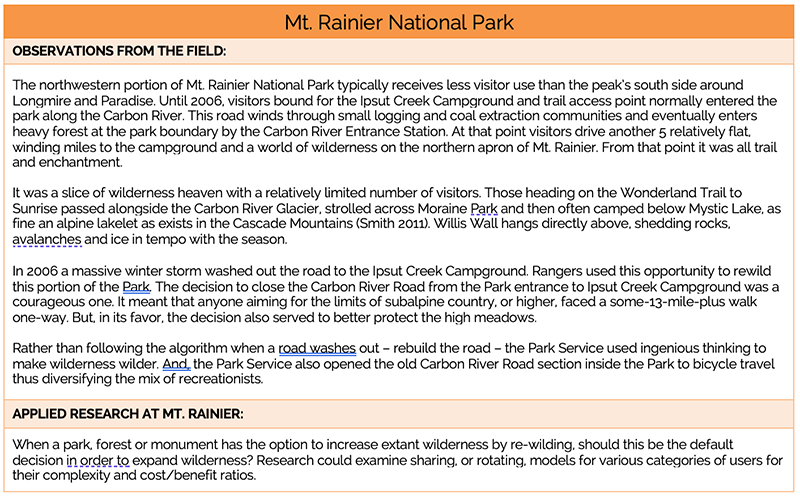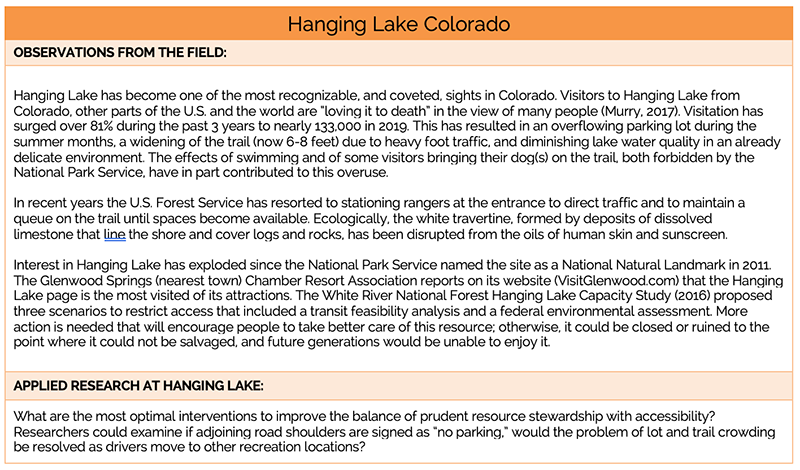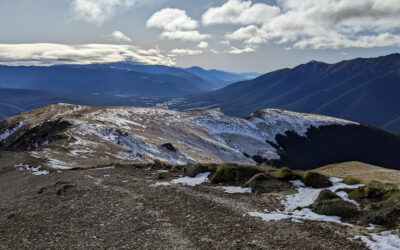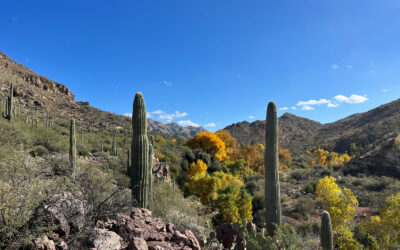Hanging Lake. Photo credit © Victoria Carodine and 5280 Magazine
A Pandemic Inspired Research Agenda on the Wilderness Experience
Communication & Education
August 2021 | Volume 27, Number 2
Some 20-plus years ago the US Forest Service’s Rocky Mountain Research Station convened a three-day workshop in Missoula, Montana, that was destined to bear remarkable fruit about visitor use density effects on the wilderness experience (Freimund and Cole 2001). In the years following this conference, United States and global populations grew abundantly, personal digital technology exploded, rural/agrarian lands were converted for commercial and housing purposes, and divisive political forces challenged any consensus about future conservation efforts and the protection of wildlands.
This tumultuous period was capped in 2020 by a world-wide pandemic (United Nations 2020) that quarantined people inside while simultaneously driving them outdoors, when allowed, to seek recreation and solace. How many wilderness managers and advocates have experienced first-hand the unanticipated perturbations of Covid-19? Visitor use of pristine and beloved natural areas has soared (Rott 2020), especially in urban- accessible wildlands, and with higher visitor demand comes numerous questions about future wilderness management. This paper explores the implications of these changes through an agenda of applied research.
A Research Agenda
In 56 years after passage of the Wilderness Act of 1964, we have seen the U.S. population increase 72% from 1964 (192 million) to 2020 (331 million estimated) whereas the global popula- tion more than doubled during this same period (3.3 billion in 1964; 7.8 billion estimated 2020) (Worldometer 2020). Designated wilderness acreage in the U.S. during this period grew from 9.1 million acres in 1964 to 111 million acres in 2020 but more than 100 million “pristine” acres remain unprotected (Wilderness Society 2020). World population growth, which directly affects U.S. wilderness quality (e.g., via air and water pollution; climate change), outpaces wilderness acre- age increase in the U.S. and large swaths of quality wilderness acreage in the U.S., and globally, remain at risk.
These statistics add structure concerning what visitors to parks, wildlands and wilderness know intuitively, suggested in Table 1, as they fight for parking, or after they have taken public transportation only to discover that trails, parks, paths, picnic tables, bike lanes, overlooks, pull-outs, lakes, beaches, restrooms, play equipment, pet areas, hot springs, rivers, campsites, ski runs, docks and all other manner of recreational resources are being used to capacity, and beyond. Population continues to be a primary unrelenting threat to our preserves and solitude (Hollenhorst and Jones 2001); a threat that is seemingly beyond the control of wilderness and natural resources managers.
It is ironic to note that the global pandemic could have a positive impact on wilderness; even though the virus is rarely viewed as anything other than detrimental. Covid-19 ultimately may motivate society to protect additional wilderness and thus arises the need for wilderness- related studies. Table 2 presents an applied research agenda with emphasis on seven focus areas to guide future investigations, and examples of potential management/policy issues to be addressed within each focus area. These examples are not exhaustive; they illustrate the plethora of important issues deserving further study.
Connecting People & Places
There may be no more compelling issue facing conservation than that of connecting people with wilderness (Van Horn and Hausdoerffer 2017). And, there is an enormous challenge ahead in linking young age groups with wildness (Boyd 2014). As one noted naturalist/philosopher observed, “They are hive creatures now, far more so than generations past, fiercely attached to their social network, which is a large part of their identity” (Tonino 2014). By definition, wilderness is a place where technology is eschewed and tranquility coveted, which translates to a fundamental disconformity when people, of any age, bring technology along.
Below the surface of this digital reality, a perplexing conundrum deserves further examination. What is the probability that public-mandated regulations can alter young recreationists proclivity to carry technology given that such technology essentially defines who they are? How can such policies be enforced? What incentives encourage a digitally-free experience when so many recreational technologies employ electronically based applications? When is technology so assimilated within a piece of equipment that it is no longer primarily technology, but instead simply one component of a larger piece of equipment and experience?
Research should explore whether the divide between wilderness boundaries and social media can be reconciled. Cell phone cover- age is limited in many wilderness areas, but that does not prevent people from bringing in smartphones for play lists, three-dimensional maps, and other microelectronic magic. Satellite phones that offer connection to society can be invasive even if they are seldom used (Kerosote 2004). Sheer presence of a technology may encourage users to take more risks than they might otherwise do if a lifeline is not available. In an overview of distraction research (caused by smartphones and similar technology), Dustin, Amerson, Rose and Lepp (2019) report that technologies are detrimental to higher order cognitive functioning while undermining wilderness experiences and opening users to mental blunders.
Connecting people and places also pertains to society’s desire to be inclusive and equitable. The U.S. supports the idea that all people should have equal access to enjoy wilderness. Despite this belief, recreational use statistics (Scott and Lee 2018) report inequality for those with lower economic means and/or for those whose families have no legacy of experiencing wilderness. Research should be focused on discerning which programs can be expanded to support diversity of experience and methodologies for channeling interested age groups (particularly the young to create a sense of legacy) toward appropriate opportunities.
Reconceptualizing Wilderness
Jack Turner’s insights on the evolving conceptualization of wilderness in The Abstract Wild (1996), drawing on the work of Arne Naess (cf. Drengson, 2005), underscores how the onslaught of unbridled population growth and economic development renders wilderness ephemeral. Modernity is making wilderness increasingly abstract. Turner lamented his personal contributions to destroying what Walter Benjamin (1968) termed the “aura” of wilderness by disseminating photographic/digital images. He lambasted rising tourism as well as curated experiences that drive the wildness out of wilderness; an irony considering that he made his living as a guide and author of eye-catching photographic images.
It is very difficult to manufacture more wilderness, yet each year demand for wilder- ness access spirals upward. This conundrum could be addressed through research that broadens, or reconceptualizes, wilderness and the wilderness/wildness duality. Authorities such as Leopold (1949) and Roderick F. Nash (1967) conclude that wilderness is self-willed; wilderness represents land that cannot be controlled while wildness has the capacity for renewal (cf. Van Horn and Hausdoerffer2017). Robert Michael Pyle (2017) posits that wildness resides along “a great, big continuum.” Toward the farthest end of this continuum lies wilder- ness where the purity of wild experience is unassailable. At the opposite end are more common places lacking wilderness quality; they are unable to qualify for designation but are also able to provide inspired moments of wildness.
Given our relative inability to produce more wilderness, it is still possible to simulate wildness. Researchers could investigate new strategies for expanding wildness by focusing on ways to balance how wildness approximates wilderness. Perhaps natural areas that do not qualify for wilderness status might receive designation as semi-wilderness. Under the right circumstances – weather, time of day/night, season, or other factor – it is conceivable that an individual might have a wilderness moment in a highly populated setting (e.g., Central Park) just as remote non-wilderness areas offer a setting where wilderness is approximated.
Although the road to wilderness designation is seldom an easy one, the path to wildness might be more promising if our policymakers and managers reimagined the possibilities for wilderness (Hollenhorst and Jones 2001). The ecosystems and landscapes that form the U.S. National Park System were relatively easy candidates for preservation due to their highly visible, charismatic qualities. Many wilderness areas could qualify for national park status if more people could access their beauty. But by designating parcels as national park quality, the very wild character we seek to preserve faces dramatically higher visitor use.
Research could explore methods for enabling visitors to perceive wildlands through a new lens (Rudzitis and Johansen 1991). Contemplate a 100,000-acre parcel of almost treeless high desert, or prairie. The challenge is finding ways to imbue this land with a visitor experience that approximates charismatic national parks. Perhaps a central theme is “a quality wild experience.” Studies could determine how to create a system of non-charismatic wildlands that rival/exceed the attention given to national parks. Instead of campgrounds that cram people into a small area, assume that a campground is developed with the idea that families have privacy. Offer an exten- sive system of cabins/huts that enable visitors to leave recreational equipment at home. Deliver meaningfully expanded educational programs that engage attendees. Study the preferences and predispositions of different age groups as well as different interest groups (McCool 2001). Involve participants so that they identify with wildness and will seek out similar offerings in the future (Borrie and Birzell 2001).
Buffering the Charismatic Protected Areas
Research should explore the relative value of expanding buffers to wilderness and charismatic national parks. National forests (193 million acres) have often served as de facto buffers to the national parks (85 million acres). An example is the Bridger-Teton and Shoshone National Forests of nearly 3.5 and 2.4 million acres respectively which protect Yellowstone and Grand Teton National Parks, especially through the 585,238-acre Teton Wilderness and 704,274-acre Washakie Wilderness. A critical research question is whether land surrounding national forests can be expanded to improve the first line of defense. Is there value in converting portions of national forest into some other higher-than-national-forest status?
The Bureau of Land Management (BLM) oversees 260 wilderness areas and 491 wilderness study areas which provide a means to semi-protect wildlands integral to the National Wilderness Preservation System (BLM 2021). The BLM manages 12.6 million acres of land that could be converted to wilderness status. In addition to the wilderness study areas, the BLM protects wildness through the Wild and Scenic River Act (200 rivers of which 81 have been officially designated as Wild and Scenic), monuments and conservation areas (11.9 million acres with 28 national monuments and 17 national conservation areas), and National Scenic and Historic Trails (6,000 miles of trails). Add the state parks and state lands to the preceding tally and it is impressive that so much, and in the minds of others “so little,” land has been protected.
Studies could explore the potential value of expanded buffering. What compromises would have to be made in the definition of wilderness to advance a new paradigm of urban-accessible wilderness? Should compromises be made to the criteria defining wilderness in urban-accessible areas? Can we alter the public mindset that assumes wilderness only occurs when there is inarguable scenic beauty and where humans are only visitors?
Mediating Threats to Wilderness
A paucity of management and policy research exists about mediating new threats to wilder- ness. The U.S. continues a reactionary approach to environmental threats rather than deploying a systematic and comprehensive response (Sikdar 2019). Some argue that limited progress is due to traditional advocacy for logging, mining, and grazing (Du Pisani 2006). Inadequate staffing within federal and state agencies also hampers the ability for government to effectively address diverse multiple-use expectations.
Expanding research into methods for mediating wilderness threats could enable managers and policymakers to act more proactively with a future focus. For example, it is commonly acknowledged that urban development will translate to higher use on wilderness and wildland resources. Yet, more instances of evidence-based research results are needed that provide sound guidance about how to ascertain projected and real impacts from proposed developments (Boller, Hunziker, Comedera, Elsassen and Krebs 2010).
Consider the natural purity of rainforest within the Olympic Peninsula of Washington state. The Hoh Rainforest is reputed to have such a silent milieu that it is viewed as one of the, if not the, quietest places in the U.S. An advocacy organization – One Square Inch (cf onesquareinch.org) – was founded to protect the “soundscape” of the Olympic National Park’s wilderness which had been registered as 100% non-natural noise free. The advocacy organization collaborated with various partners, encouraging airlines with international in-bound Seattle flights to maintain a no-fly zone. Violations have occurred, but for the most part sacred silence was maintained until the U.S. Navy expanded its fleet of “growler” jets. How was the problem allowed to occur? Had research identified effective processes for wilderness managers to follow in the event of planned stressors to their natural areas, it is possible that One Square Inch and Olympic National Park would not be responding to noise invasion after the fact.
Right to Access Nature and Wildness
The so-called “rights-of-nature” movement supported by the Global Alliance for the Rights of Nature (2011) maintains that nature has rights in the same manner that human beings have rights. Countries such as Bolivia, Columbia, Ecuador, India, and New Zealand have witnessed legal challenges by advocates promoting an Earth-rights policy. An informative example is New Zealand which in 2017 granted legal personhood to the Whanganui River (Roy 2017). In line with the proposition that nature possesses certain inalienable rights, research into wilderness issues could meaningfully explore the concept of U.S. citizens’ rights to access wilderness areas.
Many supremely attractive natural settings are already enduring over-tourism (Steen Jacobsen, Iversen and Hem, 2019) as documented in Table 4 for Hanging Lake, Colorado. When demand for visitation exceeds prudent use rationing, citizens will-be/are-being turned away. Consequently, evidence-based analyses should address the issues of who gets to access wildlands and when. Rationing methodologies usually utilize frameworks to balance use with preservation and conservation. Eventually a sufficient number of citizen “owners” will be prevented from visit- ing or using their natural assets and that will underline that capacity frameworks are insufficient to protect citizen rights.
Research could foster ingenious strategies to limit use while honoring right-to-use. For example, one approach might acknowledge that every citizen (on birth or naturalization) receives the right to one (1) multi-day visit to each national park and national wilderness in their lifetime. Citizens may seek ways to visit some natural assets more than once; but they are guaranteed to access each asset once in their lives. Much like the Social Security Administration manages various health and socioeconomic benefits, a federal entity or contractual partner, could administer the natural area/wilderness benefits for each citizen. Perhaps each citizen is allocated a ticket/ permit or other document, possibly a “Heritage voucher,” that verifies the right to use each park, national forest and associated natural area.
Building A Global Perspective
Global collaboration could substantially increase wilderness opportunities for all people even though political issues have tended to present barriers that obstruct partnerships and that work against creating basic standards, best practices and aspirations promoting national/regional/ local autonomy and character (IUCN 2021). Ironically, scientific substance, knowledge, and pragmatic know-how for saving endangered species have evolved significantly in a short period of time, yet our socio-political structures essential to implementing environmental- and species- saving changes continue to lag.
The inspiring set of international societies and conferences dedicated to resurrecting and maintaining wildlife continues to raise optimism that further loss of life or wilderness can be pre- vented. With the impressive technological tools, insightful findings from bench research and field studies, as well as the body of evidence-based knowledge at our disposal, we are sufficiently prepared, on a technical basis, to address the preservation of wildness and wilderness. Yet, across the globe we are culturally unable to reconcile our ambitious economic and mate- rial appetites with the concepts of ecosystem protection and conservation.
A vibrant research agenda should address the balance of our global demographic and economic growth with preservation of life. Edward O. Wilson (2002) characterized the challenge to save our dying world this way: “Science and technology led us into this bottleneck. Now science and technology must help us find our way through and out.” This clarion call often seems to be ignored by world leaders. Research could elucidate more effective grassroots and community-based strategies based on social media platforms. These research-based approaches effectively respond to Wilson’s urging; that is, to use powerful social media technology to effect change in saving our planet.
Buoyed by a research-informed global movement, action might ignite at local and regional levels. For example, collaborative cross-country research could validate essential requirements to build a Canada-United States-Mexico Pacific Rim ecosystem running down the spine of each country. This could become a model for a North America-South America Rim ecosystem. Using these models, other countries around the globe could conceive of their own ecosystem alliances that bridge boundaries while maintaining national sovereignty.
Although ecosystem partnerships and alliances could bring a more wholistic ecosystem approach to conservation, important hurdles will undoubtedly remain to be negotiated.
But, the first steps, often “baby-steps,” are elemental in gravitating toward large-scale research-based reform. In this regard, research comes full circle. For the immediate future, countries could forge alliances where parks/forest/ocean scientists and managerial personnel rotate among different multinational options. In this manner, cross-country collaboration and sharing of scientific experts are a fundamental start in disseminating knowledge and experience while transmitting best practices.
Wilderness in the 22nd Century
Even as the wild frontier pushed west and as Lewis and Clark made their historic trek, some began to envision an inevitable end to wilderness in the U.S. What are the prospects for wilderness as we begin to look forward to the next century? For the remainder of this century wilderness-centered research is likely to remain focused on ecosystems. How can we build beyond the confines of wilderness to create ecosystems that provide substantial diversity and a context within which living things can cope with the onslaught of climate change?
The next big wilderness experience could lie in space travel, and democratization beyond a minority of wealthy people. Research should substantiate the clarion warning of Covid-19: too many people exceed the carrying capacity of our earthly sphere. As people and wildlife populations collide, inevitably we will experience migration of extraordinarily deadly viruses across species lines that will make Covid-19 seem like a common cold. A potent virus might return global population to levels extant some 100-200+ years ago. If this occurs, will the surviving population use the opportunity to rewild the globe? Or, will the focus be on catch- ing back up to where things left on before the contagion brought its brutal finality.
Researchers can explore when the tipping point occurred in the loss of U.S. wilderness and then correlate this with the demographics at that time. Under what parameters does a pandemic become an unfortunate and sorrowful point for rewilding and establishing new wilderness boundaries? What are the likely probability that an enlightened, but dramatically reduced, popu- lation will not repeat egregious environmental degradation that cultivates rampant viruses?
Looking Toward the Future
When the post-pandemic period arrives, enormous value will to be gained by learning from the pandemic itself. In early 2020, citizens of the United States went to ground reaching for seclusion, prevention, and protection from the virus. Nonetheless, quarantine, confinement
and isolation seemingly had a 6-month half-life before people began ignoring recommended best practices to prevent viral infection. Discovery of vaccines at the end of 2020 contributed to a sense that the end of the pandemic could be near. Yet, by the time the vaccine was being distributed in late 2020, there was no well-functioning vaccine distribution system despite prior forewarning. In so many respects, like Nero, we essentially fiddled while Rome burned.
Now is the perfect time to recommit our wilderness leaders, managers, scientists, policy makers and advocates to bold and incisive actions that are informed by applied research.
By establishing the Wilderness Act of 1964, our society confirmed that wilderness and wildland resources are highly treasured. These resources are too valuable to repeat the lack of implementation planning, foot-dragging and administrative confusion that accompanied the pandemic. Now is the perfect time to recommit our wilderness leaders, managers, scientists, policy makers and advocates to bold and incisive actions that are informed by applied research.
About the Authors
HOWARD SMITH is a professor in the Milgard School of Business at the University of Washington Tacoma: email:smithhl@uw.edu
RICHARD DISCENZA a Professor and Dean Emeritus at the University of Colorado at Colorado Springs: email: rdiscenz@uccs.edu.
ROBERT DVORAK is editor-in-chief of IJW and professor in the Department of Recreation, Parks, and Leisure Services Administration at Central Michigan University: email: dvora1rg@cmich.edu
References
Benjamin, W. 1968. Illuminations. New York: Schocken Books.
Boller, F, M. Hunziker, M. Conedera, H. Elsasser, and P. Krebs.2010. Fascinating Remoteness: The Dilemma
of Hiking Tourism Development in Peripheral Mountain Areas. Mountain Research and Development 30(4), 320-331, (1 November 2010). https://doi.org/10.1659/MRD-JOURNAL-D-10-00018.1
Borrie, W. T., and R. M. Birzell. 2001. Approaches to measuring quality of the wilderness experience. In:
Freimund, W.A.,Cole, D.N., 2001. Visitor use density and wilderness experience: proceedings; 2000 June 1-3; Missoula, MT. Proc. RMRS-P-20. Ogden, UT: U.S. Department of Agriculture, Forest Service, Rocky Mountain Research Sta- tion:29-38.
Boyd, D. 2014. It’s Complicated: The Social Lives of Networked Teens. New Haven: Yale University Press.
Bureau of Land Management. 2021.What we manage. https://www.blm.gov/about/what-we-manage/national.
Drengson, A. 2005. The Selected Works of Arne Naess. San Francisco: The Foundation for Deep Ecology.
Du Pisani, D. P. 2006. Sustainable development – historical roots of the concept. Environmental Sciences 3(2): 83-96.
Dustin, D. K. Amerson, J. Rose, and A. Lepp. 2019. The cognitive costs of distracted hiking. International Journal of Wilderness 25(3): 12-23.
Freimund, W. A. and D. N. Cole. 2001. Visitor use density and wilderness experience: Proceedings; 2000 June 1-3; Missoula, MT. Proc. RMRS-P-20. Ogden, UT: U.S. Department of Agriculture, Forest Service, Rocky Mountain Re- search Station.
Global Alliance for the Rights of Nature. 2011. The Rights of Nature, The Case for a Universal Declaration on the Rights of Mother Earth released on April,20, 2011 by the Global Exchange, the Council of Canadians, The Pa- chamama Alliance, and Fundación Pachamama (cf. https://therightsofnature.org/what-is-rights-of-nature/ accessed 12/19/20)
Hollenhorst, S. J., and C. D. Jones. 2001. Wilderness solitude: beyond the social-spatial perspective. In: Freimund, W.A.,Cole, D.N., 2001. Visitor use density and wilderness experience: proceedings; 2000 June 1-3; Missoula, MT. Proc. RMRS-P-20. Ogden, UT: U.S. Department of Agriculture, Forest Service, Rocky Mountain Research Sta- tion:56-61.
International Union for Conservation of Nature 2021. https://www.iucn.org/theme/protected-areas/about/iucn- global-protected-areas-programme.
Kerasote, T. 2004. Out There: In the Wild in a Wired Age. Stillwater, MN: Voyageur Press.
Leopold, A. 1949. A Sand County Almanac. New York: Oxford University Press.
McCool, S. F. 2001. Limiting recreational use in wilderness: research issues and management challenges in apprising their effectiveness. In: Freimund, W.A.,Cole, D.N., 2001. Visitor use density and wilderness experience: proceedings; 2000 June 1-3; Missoula, MT. Proc. RMRS-P-20. Ogden, UT: U.S. Department of Agriculture, Forest Service, Rocky Mountain Research Station.
Murry, J. 2017. Hanging Lake visitors are up 81 percent. Is it being loved to death? The Denver Post. April 17, 2017
Nash, R. F. 1967. Wilderness and the American Mind. New Haven: Yale University Press.
Pyle, R.M. 2017. In: Van Horn, G. and Hausdoerffer. 2017. Wildness: Relations of People and Places. Chicago, IL: Uni- versity of Chicago Press.
Rott, N. 2020. ‘We Had to Get Out’ Despite the Risks Business is Booming at National Parks. Morning Edition. National Public Radio. Aired 5:00 a.m. ET, August 11, 2020. Accessed at https://www.npr.org/2020/08/11/900270344/we- had-to-get-out-despite-the-risks-business-is-booming-at-national-parks.
Roy, E. A. 2017. ‘New Zealand river granted same legal rights as human being’. The Guardian. London, United King- dom. Retrieved 9 March 2021.
Rudzitis, G., and Johansen, H.E. 1991. How important is wilderness? Results from a United States Survey. Environmen- tal Management (15): 227–233.
Scott, D. and Lee, K .F .F. 2018. People of color and their constraints to national parks visitation. The George Wright Forum 35(1): 73-82.
Sikdar, S. 2019. Environmental protection: reactive and proactive approaches. Clean Technologies and Environmen- tal Policy 21: 1–2.
Smith, H.L. 2011. The Last Best Adventure. CreateSpace.
Steen Jacobsen, J. K., N. M. Iversen, and L. E. Hem. 2019. Hotspot crowding and over-tourism: Antecedents of desti- nation attractiveness. Annals of Tourism Research 76 May. 53-66.
Tonino, L. 2014. Not on any map: Jack Turner on our Lost intimacy with the Natural World. The Sun Magazine: Cha- pel Hill, NC. Accessed at https://www.thesunmagazine.org.
Turner, J. 1996. The Abstract Wild. Tucson: The University of Arizona Press.
Van Horn, G. and Hausdoerffer. 2017. Wildness: Relations of People and Places. Chicago, IL: University of Chicago Press.
United Nations, 2020. Policy brief: Covid-19 in an urban world. Accessed December 30, 2020 at: https://www.un.org/ sites/un2.un.org/files/sg_policy_brief_covid_urban_world_july_2020.pdf
White River National Forest Hanging Lake Capacity Study, 2016, accessed at https://rosap.ntl.bts.gov/view/ dot/12291.
Wilderness Society. 2020. Wilderness Designation FAQs. Accessed December 29, 2020 at https://www.wilderness. org/articles/article/wilderness-designation-faqs#
Wilson, E.O. 2002. The Future of Life. New York: Knopf, xxiv.
Worldometer, 2020. Elaboration of data by: United Nations, Department of Economic and Social Affairs, Population Division. World Population Prospects: The 2019 Revision. (Medium-fertility variant). Accessed at (www.Worldom- eters.info).
Read Next
Forgetting Your Anniversary, Again
This year represents the 30th anniversary of the International Journal of Wilderness.
The Trouble with Virtual Wilderness
How the history of the 20th-century wilderness movement might give us different moral guidance as we confront this new technology.
Revisiting Human’s Role in Wilderness
The question we must ask ourselves today is familiar: Are we guardians, or are we gardeners?

